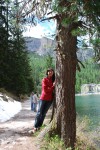Kim Martineau, science writer for The Earth Institute, became a journalist to discover the world, explore the human condition and reveal the truth hiding in a string of facts. As a newspaper writer for the Times Union in Albany, NY, and The Hartford Courant in Connecticut, she wrote about crime and punishment, small town government, higher education and the environment. She was twice named a finalist for the Livingston Awards for Young Journalists for profiling a transgender student at Yale and a Nobel Prize-winning chemist accused of stealing the rights to his own invention. A story that she broke about an antique map dealer caught slicing maps out of ancient books at a Yale library received national attention. She lives in New York City with her husband and a rabbit possibly old enough to qualify for the book of Guinness World Records.

Max Cunningham, a graduate student at Lamont-Doherty, traveled to Costa Rica’s Mount Chirripó this past summer to test the idea that mountain glaciers carved the summit we see today. He and his colleagues hope to eventually pin down when Chirripó’s high-elevation valleys eroded into their current form. Check out a recap of their 2014 field season.

Bend a rock. Channel your historic ‘birthquake.’ Check out rocks, fossils, sediment cores and more at Lamont’s Open House on Saturday, October 11.

For the last decade or so, Columbia University geologist David Walker has led students and colleagues on a tour of the geologic gems hiding within Columbia’s campus. Along the way, Walker finds evidence of how life on Earth has evolved over 4.5 billion years.

Geologist Nicholas Christie-Blick has studied the Death Valley region for more than four decades. Each spring, he leads a group of Columbia University undergraduates there on a fieldtrip. Check out highlights from this year’s trip.

Four years ago this month, archeologists monitoring the excavation of the former World Trade Center site uncovered a ghostly surprise: the bones of an ancient sailing ship. In a new study, scientists at Lamont-Doherty Earth Observatory say that an old growth forest in the Philadelphia area supplied the white oak used in the ship’s frame, and that the trees were probably cut in 1773 or so—a few years before the bloody war that established America’s independence from Britain.

Geologist John Templeton recently spent a year on Norway’s west coast trying to understand how rocks now at the surface made an epic journey deep into Earth’s interior and back during the growth and subsequent collapse of the ancient Caledonian mountains. Check out a photo essay describing his work.

A new video, “Flip Flops and Outcrops,” captures good vibrations from a recent Columbia University geology field trip to the Caribbean island of Barbados

Peter Kelemen, a geologist at Lamont-Doherty Earth Observatory who studies rocks from the deep earth and, recently, their possible uses in battling climate change, has been elected to the National Academy of Sciences.

Bess Koffman, a postdoctoral researcher at Lamont-Doherty Earth Observatory, recently traveled to New Zealand to collect dust ground-up by glaciers during the last ice age. In this photo essay, she explains how she collected the dust, what analysis looks like in the lab and what she hopes to learn.

Climate Scientist Lisa Goddard talks about what may be behind the recent slowdown in global warming, and some of the nuances of predicting just how the climate will change.











